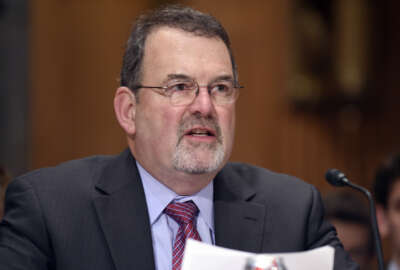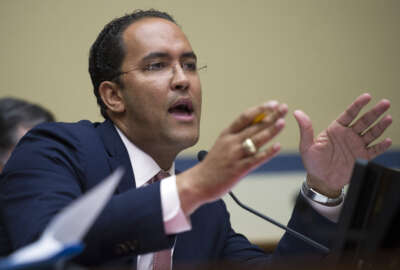

IDC Government found the federal government spends almost four times as much on technology per employee on average than other industries.
Another reason Congress should get on board with the IT Modernization Fund or the MOVE-IT Act: The cost of technology per federal employee on average is more than $39,000. Yes you read that correctly, the government spends per worker on average the same as if you bought a new Cadillac XT5 or a Lexus RC 200t or a Volvo XC70.
Shawn McCarthy, the research director IDC Government, collected the data and did the math to find once he removed the education and government sectors, the average industry spends four times less than the federal government for IT per employee based on 2013 dollars.
| Federal Governmentwide Average – IT Spending per Employee | |
| Federal Government | $39,176.60 |
| Across All Other Industries | $9,887.32 |
| Source: Shawn P. McCarthy – Research Director, IDC Government Insights | |
“The government is not in the business of selling things for a profit so it’s much more difficult to justify upgrading systems than it might be if you were in retail or manufacturing,” McCarthy said. “In those industries, you can do a return on investment analysis and say, ‘if we upgrade so that people can shop with us directly and we can boost sales by four percent, then it’s worth spending ‘X’ million on upgrading that system.’ The government can’t hold the profit motive as one of their reasons so they have to find other reasons to upgrade. It might be improving citizen services. It might be cutting long term costs. But it might be difficult to go to Congress and say, ‘hey we just realized that if we invest $20 million in this system and we can save $30 million over the next 8-to-10 years. When you are in Congress and your constituents are saying, ‘don’t raise my taxes,’ it can be very difficult to say, ‘I’m going to raise taxes this year to pay for this new system and we are going to save money in the long term.’ The government has some baggage when it comes to making these investments that other industries don’t face.”
It’s that baggage that federal chief information officer Tony Scott continues to use to make his case to industry and legislators alike.
Scott, who spoke at the recent FCW Cyber Summit in Washington, said the government’s old technology deficit is up to $7.5 billion over the next three years. This means based on his conversations with three large suppliers of network hardware and software, the amount of technology that will need to be replaced because it’s going “end of life” has grown by $4.5 billion since May.
“This is mostly hardware and it doesn’t count software and it doesn’t count the stuff that already has gone end of life,” Scott said. “All that stuff is attractive to people who want to attack us. It creates a large surface area and until we get that stuff replaced and upgraded, and put in place a more secure architecture, infrastructure and applications, we will have a problem. That’s just a fundamental.”
McCarthy’s research supports Scott’s secondary premise that old infrastructure costs too much to maintain and forces agencies into making hard budget decisions about new versus old.
McCarthy said the key to cutting costs in an IT environment like the governments is to tightly focus on asset management.
“By using an asset management approach, you are asking if you are being as efficient as you can with what you have,” McCarthy said. “Our company works with government clients to look at all aspects of their asset portfolio and we often find software licenses that they paid for but don’t use, storage capacity that is well-underutilized or could be more efficient and effective. There are a number of ways you could trim costs from existing programs, which is really job one where new funding is very difficult to come by.”
| Federal Governmentwide Average – IT Spending per Employee | |
| Top Agencies | Spending per Employee |
| Veterans Affairs Department | $12,993.30 |
| Department of the Interior | $14,423.50 |
| U.S. Army Corps of Engineers | $19,113.30 |
| Bottom Agencies | Spending per Employee |
| Department of Energy | $104,367.70 |
| Department of Education | $164,892.60 |
| Department of Health and Human Services | $187,580.40 |
| Source: Shawn P. McCarthy – Research Director, IDC Government Insights | |
The Office of Management and Budget recognizes this asset management challenge is related to the funding challenge agencies face. That’s why it’s been pressing agencies to get their assets under better control. OMB’s six memos over the past year focused on improving how agencies manage and buy technology, from data centers to software licenses to laptops and desktops.
And it also may be the reason way Scott, for the first time, publicly supported the Modernizing Obsolete and Vulnerable Enterprise IT (MOVE-IT) Act.
He said there is room for both the administration’s IT Modernization Fund (ITMF) proposal and this new bill from Reps. Will Hurd (R-Texas), chairman of the Oversight and Government Reform Subcommittee on IT, and Gerry Connolly (D-Va.) and Sens. Jerry Moran (R-Kan.) and Tom Udall (D-N.M.).
“There is no good and bad here. I think these are all attempts to solve a real hard problem that we have. The question is really what’s the best combination of things that we can put together to really go attack this in a meaningful way? That’s where everybody is headed,” he said in an interview after the event. “Obviously, you need a bunch of good ideas and then out of that will come a final package of some kind that I will hope will emerge and really give us some tools to attack this.”
Scott said the MOVE-IT Act is a good companion piece to the ITMF.
“The MOVE-IT Act creates a working capital fund in each agency, but unfortunately there is no actual funding that comes along with it,” he said. “If you put the two together you have a good concept.”
By having the short term infusion of funding from the ITMF and the long-term ability of agencies to keep savings and repurpose them for new projects, it would address the challenges McCarthy says is driving up the cost of IT per employee in the government.
But even if Congress fails to come through with either proposal, Scott said OMB is finishing up its guidance for how CIOs can move toward a continuous technology refresh cycle.
OMB released draft policy obtained by Federal News Radio in February detailing a four-step plan to help agencies plan for IT upgrades.
“The guidance is not ITMF specific. Whether there is ITMF or MOVE-IT or some combination of that or none, the guidance we are going to give is good practice no matter what. It’s intended to address a lot of things…like CIOs identifying what legacy they have, outlining the plans that they could put together to replace it and really sending a signal to what the real need is,” Scott said in late August.
Copyright © 2025 Federal News Network. All rights reserved. This website is not intended for users located within the European Economic Area.
Jason Miller is executive editor of Federal News Network and directs news coverage on the people, policy and programs of the federal government.
Follow @jmillerWFED


